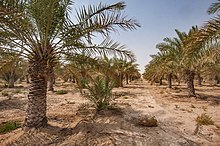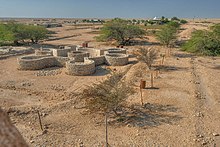Agriculture in Qatar
Agriculture in
Although the relative importance of these activities has declined as a means of livelihood (with commercial pearling disappearing completely), the government has attempted to encourage
History
Date palms were one of the earliest crops to be cultivated in the peninsula.[3] Beginning in the Bronze Age, the trading of date palms had a significant impact the Qatari economy.[4] Date palm leaves were also commonly used as a construction material.[5] However, as Qatar's geography and climate was unsuitable for large-scale crop cultivation, the bartering of date palms had a lesser impact on Qatar's revenues than did pearling. As the waters surrounding Qatar contain some of the most abundant pearling beds in the world, this was the main source of income for Qatar's inhabitants until the discovery of oil the 20th century. Pearl trading was supplemented in some areas by camel breeding. Fishing also played an important role in the economy.[6]
"The principal and almost the exclusive source of livelihood in Qatar is pearl-fishing, supplemented in some places by the breeding of camels. Agriculture hardly exists. The only date palms-- and they are not numerous-- appear to be those in the gardens at
Na'aijah, Sakkak, Sakhamah and Wakrah; and it is not clear that any vegetable gardens exist except at some of the same places, A few semi-wild clumps of dates are found on the west coast near Dohat-as-Salwa. Besides camels the settled villagers have a few horses and cattle, which they keep in their own possession, and some sheep and goats which are tended for them by the Bedouins. They also fish along the coast of the district.These remarks are not intended to apply to the Bedouins of Qatar, who are pastoral in their habits, like the rest of their race elsewhere, and own livestock in the proportions usual among Arab nomads."

| City | Fishing boats | Camels | Horses |
|---|---|---|---|
| Khor Hassan | 5 | 20 | 0 |
| Abu Dhalouf | 10 | 30 | 0 |
Ar Ru'ays |
10 | 20 | 4 |
| Fuwayrit | 12 | 100 | 20 |
| Al Thakhira | 5 | 10 | 0 |
| Al Khor | 30 | 100 | 0 |
| Simaisma | 10 | 70 | 6 |
| Al Daayen | 10 | 60 | 10 |
| Lusail | 3 | 70 | 20 |
| Doha | 90 | 800 | 150 |
| Al Wakrah | 30 | 150 | 40 |
After Qatar began reaping significant monetary returns from oil drilling in the 1950s to 1960s, the number of Qataris employed in agriculture witnessed a decline, as the country now had the capacity to import large amounts of food.[9]
When food prices starting rising in the early 1970s, Qatar realized the importance of attaining food self-sufficiency. At the beginning of 1974, the emirate requested the Arab Organization for Agricultural Development to send researchers to study it and corroborate their results with those of an earlier UN report of the country's terrestrial and marine resources. After nearly half a year of study starting in July 1974, the research mission submitted its report to the government in November 1974. In September of that year, Qatar created a committee which would examine ways to help boost the country's agricultural development. A report released by Qatar's ministries, also in 1974, disclosed that agriculture only accounted for 0.65% of all contributions to Qatar's GDP.[9]
Cultivation and livestock


Only 2.5% (28,000 ha.) of the land in Qatar is arable or suitable for use as pastureland. This is a major increase from the two prior decades. In 1996, 8,312 ha. of land was arable, while in 1980 only 2,256 ha. was arable.[3]
Farming currently plays only a minor role in the economy. Of the 8,312 ha. of arable land in 1994, 2,345 ha. were used to cultivate
Between 1960 and 1970 agriculture grew.
In July 2017, following the
By 2019, Qatar's vegetable output increased by 20% since mid-2017 to 66,000 tonnes per year. It is expected to further increase by 20,000-40,000 tonnes by 2020. Prior to the
Soils
Qatar's soils vary in soil texture, ranging from sandy loam to heavy calcareous clay. The majority of cultivation that occurs is on clay loam soil. However, there are numerous problems with this soil, including high salinity levels, low amounts of nutrients, and a bad water-infiltration rate.[9] Most of the soils in Qatar are orthents, meaning they lack horizon development and are very shallow.[15]
Pearling
Pearling was the main source of revenue for Qatar until the discovery of oil in 1939.[16] Approximately 85 pearl beds exist in Qatar's territorial waters.[17] Historically, the season for pearl harvest was divided into 3 periods. Hansiyah lasted for 40 days and commenced in mid-April. Ghaus Al Kebir, the primary pearl diving season, took place from May to 10 September. Lastly, Ruddah occurred from late September to early October.[18] Sambuk, a type of dhow, was traditionally used for pearling trips. From the 18th to 20th centuries, the majority of pearls were exported to Mumbai where they would be classified and sent to European markets. The remaining yield would be sent to markets in Baghdad.[19]

| City | Number of boats | Number of men |
|---|---|---|
| Khor Hassan | 20 | 240 |
| Abu Dhalouf | 20 | 200 |
Ar Ru'ays |
18 | 270 |
| Fuwayrit | 35 | 420 |
| Al Thakhira | 15 | 180 |
| Al Khor | 80 | 1200 |
| Simaisma | 50 | 600 |
| Al Daayen | 70 | 840 |
| Lusail | 9 | 90 |
| Doha | 350 | 6300 |
| Al Wakrah | 150 | 2550 |
Zubarah, a settlement on the northwest coast of Qatar, is one of the best preserved and most extensive pearling settlements in the region.[20] Reaching its climax in the 18th century, it was primarily an emporium and pearling settlement that capitalized on its proximity to pearl beds, possession of a large harbour and its central position on the Persian Gulf routes.[21][22] After the introduction of the cultured pearl and the Great Depression in the 20th century, pearling ceased to be a viable option for many Qataris.[16]
Fishing
The Qatar National Fishing Company was incorporated in 1966 to fish for shrimp in territorial waters and to process catches in a refrigerated factory.[2] Japan is a large market for Doha's commercial fish.[2] The total catch of fish and other aquatic animals for 1989 was 4,374 tons.[2]
Limitations

Severe conditions, such as extremely high temperatures and lack of water and fertile soil, hinder increased
References
- ISBN 9781633559851.
- ^ OCLC 29548413.)
 This article incorporates text from this source, which is in the public domain.
This article incorporates text from this source, which is in the public domain.{{cite encyclopedia}}: CS1 maint: postscript (link - ^ a b c "Geography and population". Food and Agriculture Organization. Retrieved 13 July 2015.
- ISBN 978-1781250709.
- ^ John Lockerbie. "Old buildings". catnaps.org. Archived from the original on 2 November 2018. Retrieved 15 December 2015.
- ^ "'Gazetteer of the Persian Gulf. Vol. II. Geographical and Statistical. J G Lorimer. 1908' [1532] (1647/2084)". Qatar Digital Library. Retrieved 26 July 2015.
- ^ "'Gazetteer of the Persian Gulf. Vol. II. Geographical and Statistical. J G Lorimer. 1908' [1526] (1641/2084)". Qatar Digital Library. Retrieved 6 July 2018. This article incorporates text from this source, which is in the public domain.
- ^ "'Gazetteer of the Persian Gulf. Vol. II. Geographical and Statistical. J G Lorimer. 1908' [1533] (1648/2084)". Qatar Digital Library. Retrieved 26 July 2015.
- ^ S2CID 153502951.
- ^ "Agriculture and Fisheries". Qatar e-Government. Retrieved 18 July 2018.[permanent dead link]
- ^ Zahraa Alkhalisi and Tuqa Khalid (12 July 2017). "Qatar airlifts in cows after Arab embargo cuts milk supplies". CNN Money. Retrieved 27 August 2017.
- ^ Irfan Bukhari (7 August 2017). "Baladna Farm plans to meet Qatar's dairy needs by April 2018". The Peninsula. Retrieved 15 September 2017.
- ^ "Self-sufficiency in some agricultural sectors by 2022". The Peninsula. 21 March 2018. Retrieved 20 July 2018.
- ^ "With cows, chickens and greenhouses, Qatar takes on regional boycott". Reuters. Retrieved 5 June 2019.
- ^ a b Al-Kubaisi, Mohammed Ali M. (1984). Industrial development in Qatar: a geographical assessment (PDF). Durham E-Theses, Durham University. p. 15.
- ^ a b "Pearl Diving in Qatar". USA Today. Archived from the original on 19 August 2018. Retrieved 26 May 2015.
- ^ Al-Kubaisi, Mohammed Ali M. (1984). Industrial development in Qatar: a geographical assessment (PDF). Durham E-Theses, Durham University. p. 17.
- ^ ISBN 978-0907151500.
- ^ Casey & Vine, p. 52
- ^ "Al Zubarah Archaeological Site". UNESCO. Retrieved 14 February 2015.
- ^ Bowen R. Le B. 1951: The Pearl Fisheries of the Persian Gulf. In The Middle East Journal 5/2: 161–180.
- ^ "The Pearl Emporium of Al Zubarah". Saudi Aramco World. December 2013. Archived from the original on 2015-02-15. Retrieved 1 March 2015.
- ^ ISBN 978-9058093905.
